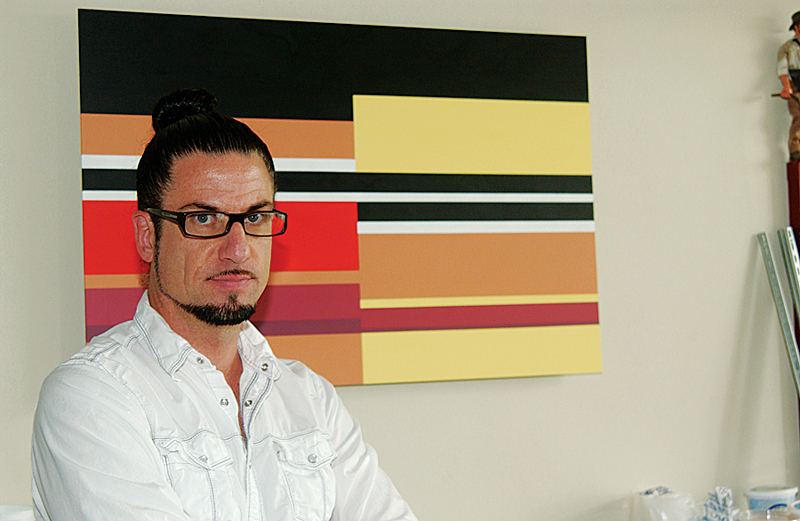Troy Gua is a late-blooming artist who had his breakthrough three years ago with hybridized portraits of pop-culture icons. Thus, the faces of Jack Kennedy and Jack Kerouac are eerily superimposed on each other, their features slightly out of register, as are Ronald McDonald and Ronald Reagan, and Salvador Dalí and the Dali Lama. The bright, glossy mashups have become Gua’s signature, and you can now order them via his website (troygua.com), juxtaposing your face with, well . . . anyone you like. “Those are my bread and butter, so to speak,” says Gua in his tidy Beacon Hill home studio. “I’ve done quite a few commissions. I continue to make them, but they’re not my focus.”
Instead, as bright western light beams in through the windows, he wants to talk about a new series of works, which he calls Colorbandz™, to be unveiled at Artopia.
“This is going to be the debut,” says Gua, laying out what seems to be a purely abstract series of colorful stripes. In fact, it’s a portrait that distorts familiar celebrity icons into bands of color. Thus, he explains, the signature hues of Muppets Ernie and Bert—a beloved childhood TV fixation—are streaked and stretched into horizontals of yellow, orange, red, mustard, and black. If you look at a conventional portrait, their noses, eyes, and sweaters have a chromatic correspondence with Gua’s “bandz.”
The striated pattern resembles a flag, as do the color-coded features of icons like Oprah, Lady Gaga, and Chewbacca. Yes, Star Wars action figures look down by the dozens from shelving in Gua’s studio, where he carefully hand-paints each portrait based on the streaks and dimensions of images manipulated in Photoshop.
There’s a reduction at work here, what Gua calls “the logo-ization of an image, to eliminate any normal cues that you would get in a figurative portrait. We only see everything as if we’re flying by [at great speed].” Each painting thus becomes a kind of synecdoche of its subject, the form distilled to its few key colors. Once you get the trick, your eye begins to scan for the clues that might be compressed again into a conventional portrait. Appropriately, says Gua, “I’m gonna have a little placard at the end” of the Artopia exhibit, meaning visitors will have to first guess his celebrity subjects’ identities.
“TV, movies . . . I love it all. I’m a pop-culture whore,” he chuckles. “I get infatuated with these famous icons. I’m into their studious cultivation of identity.” Examples from his youth include Elton John, David Bowie, Michael Jackson, and Prince. “I would love to go back to that time,” he says. “And maybe I’m trying to recapture that in nostalgia.”
Gua also sees in such figures a hyper-self-aware, carefully constructed image that can change daily (via hair, makeup, and clothing) or gradually (through dieting, plastic surgery, etc.). Like Madonna and Lady Gaga, they make their faces and bodies their brand, effectively becoming pictograms of themselves, which corresponds to Gua’s interest in logos, glyphs, and Facebook screen icons. It’s all about repetition and permutation: Once you see the essence, be it Elvis’ curled lip, Marilyn’s hair, or Hitler’s mustache, he laughs, “It’s burned into our minds!”
Likewise, says Gua, who often puts his own face into his work, “I got my own brand. I got my bun”—he points to his distinctive hair and beard—”and that’s how people recognize me. It’s a tool.”
But Gua’s work isn’t all icons and portraiture, though his pop hybrids remain on view at SAM’s TASTE restaurant this summer. Beginning on Saturday, July 16, he’ll participate in MadArt’s group show/installation Mad Houses on a Capitol Hill block (at Bellevue and Roy) where Gua will envelop an entire condemned home in shrink-wrap. (After the wrecking ball swings in August, various artifacts will move to the UW’s Jacob Lawrence Gallery.)
“It’s a pretty good-sized house, a 30-foot-tall Craftsman,” says Gua excitedly, who’ll wrap it like a parcel for shipment. And the best part? He gets to design his own mailing label and bar code for it—another reduction to stripes and patterns.








